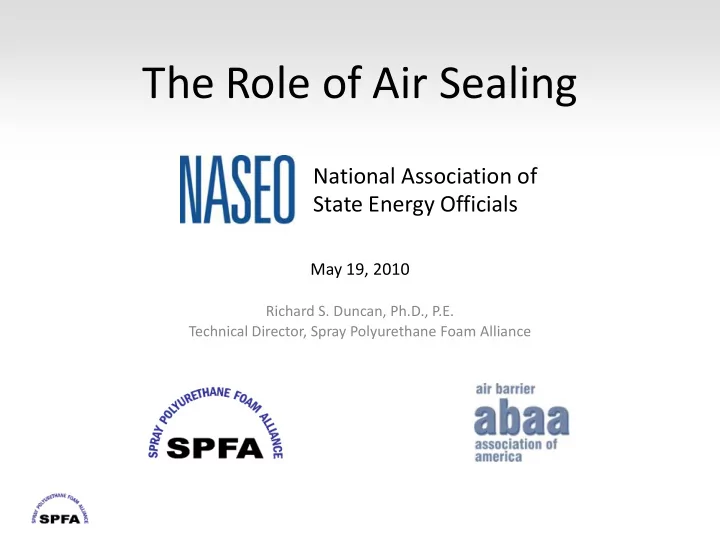

The Role of Air Sealing National Association of State Energy Officials May 19, 2010 Richard S. Duncan, Ph.D., P.E. Technical Director, Spray Polyurethane Foam Alliance
Overview • Building Enclosure Functions Air Leakage in Buildings • • Air Barrier Materials Building Codes and Market Drivers •
Building Enclosure Requirements
Air Leakage in Buildings How it Occurs • • Impact – Health and Safety Durability – – Occupant Comfort – Heating and Cooling Costs
Air Leakage in Buildings: How it Occurs Pressure differences drive air leakage • Buoyancy or stack effect • Wind Action • Flues and Ventilation Systems Air Leakage will cause… • Poor indoor air quality • Deficient control of moisture • Loss of occupant comfort • Increased energy costs
Air Leakage in Buildings: How it Occurs Pressure differences drive air leakage • Buoyancy or stack effect • Wind Action • Flues and Ventilation Systems Air Leakage will cause… • Poor indoor air quality • Deficient control of moisture • Loss of occupant comfort • Increased energy costs
Air Leakage in Buildings: Impact • Health and Safety – Mold / Mildew – Structural Damage
Air Leakage in Buildings: Impact • Durability – Corrosion – Rot
Air Leakage in Buildings: Impact • Occupant Comfort – Cold Drafty Rooms – Poor Indoor Air Quality – Minimal Humidity Control The average home has the equivalent of a 2 square foot opening due to the total discontinuities (cracks and gaps) in the building envelope. This is equivalent to leaving a window fully open – year round!
Air Leakage in Buildings: Impact • Heating and Cooling Costs – Conditioned Air Loss – Humidity Control According to DOE, unwanted air leakage can account for nearly 1/3 of the heating and cooling energy costs of a typical home A recent NIST study shows that typical commercial buildings can reduce air leakage by more than 80% with air barriers….saving 25- 40% in heating bills (NIST Report 7238 - June 2005)
Air Barrier Materials • Air Barrier – A designated "plane" of reduced air flow between different environments • material / component • assembly • system • Requirements – Low Air Permeance – Continuous – Structural/Durable
Air Barrier Materials SELF-ADHERED SHEET FLUID-APPLIED LIQUID FLUID-APPLIED SPRAY FOAM MECHANICALLY FASTENED MECHANICALLY FASTENED THERMOFUSIBLE MEMBRANE (FILM/HOUSEWRAP) (BOARDSTOCK)
Building Codes and Market Drivers • State Codes • Adopted in MA, WI, MI, MN, GA, RI, FL • Consideration in NY, NC, SC, OR, CA • ASHRAE 90.1 • 2007: Proposed continuous air barrier in colder climates • 2008: Approved by ASHRAE, but overturned • IECC • Requires sealing, no methods defined • Proposal (in progress) include continuous air barrier like ASHRAE 90.1 (submitted by AIA)
Building Codes and Market Drivers • Market Forces • ASHRAE/USGBC Standard 189 P for LEED • AIA 2030 Challenge • Army Corps of Engineers • GSA • Energy Security • Climate Change
Building Codes and Market Drivers Air Barriers are a necessary component for all buildings to: • Improve Health and Safety • Increase Durability • Enhance Occupant Comfort • Reduce Energy Use and GHG
Thank You! • Questions? To learn more… • Comments? • Suggestions? www.sprayfoam.org www.airbarriers.org
Additional References Relevant Codes and Standards • ASHRAE Handbook of Fundamentals • Envelope Design Guidelines for Federal Office Buildings: Thermal Integrity and Airtightness by Persily, A.K., NISTIR 4821 U.S. Department of Commerce. 1994. • Massachusetts Energy Code for Commercial Buildings, 780 CMR, Chapter 13, 2001. • National Building Code of Canada, NBC Chapter 5. Additional References • Whole Building Design Guide - Products and Systems • Building Envelope Design Guide: Wall Systems, Cast-in-Place Concrete Wall Systems, Exterior Insulation and Finish System (EIFS), Masonry Wall Systems, Panelized Metal Wall Systems, Precast Concrete Wall Systems, Thin Stone Wall Systems • Federal Green Construction Guide for Specifiers: 01 57 19.11 (01352) Indoor Air Quality (IAQ) Management 07 10 00 (07100) Dampproofing & Waterproofing 07 20 00 (07200) Thermal Protection 07 50 00 (07500) Membrane Roofing 07 92 00 (07900) Joint Sealants Air Barrier Association of America
Additional References Additional References (continued) Air Leakage Characteristics, Test Methods and Specifications for Large Buildings by Proskiw, G. and Phillips, B.—Prepared for Canada Mortgage and Housing Corporation, 2001. Air Leakage Control by Lux, M.E., and Brown, W.C. NRC, 1986. Air Leakage in Buildings by Wilson, A.G. CBD 23, NRC, 1961. Air Leakage Tests on Polyethylene Membrane Installed in a Wood Frame Wall by Shaw, C.Y. NRC, 1985. The Air Permeance of Building Materials by Bombaru, Jutras, and Patenaude. CMHC, 1988. The Airtight House: Using the Airtight Drywall Approach by Lischkoff, J. and Lstiburek, J. 1986. Builders' Field Guides by Lstiburek, J. Westford, MA: Building Science Corp., 2001. Building Science for a Cold Climate by Hutcheon, N. and Handegord, G.O.P. National Research Council of Canada, 1983. Control of Air Leakage is Important by Garden, G. K., CBD 72, NRC, 1965. The Difference Between an Air Barrier and a Vapor Barrier by Quirouette, R. NRC, 1985. Energy Impacts of Infiltration and Ventilation in U.S. Office Buildings Using Multi-zone Airflow Simulation by Emmerich, S.J. and Persily, A.K.—A paper delivered at the ASHRAE IAQ and Energy Conference, 1998. "The Impact of Airtightness on System Design" by Anis, W. ASHRAE Journal, 2001. NIBS/BETEC/DOE/ORNL Spring Symposium: Air Barrier Solutions by Pollock. 2001. Stack Effect in Buildings by Wilson, A.G. and Tamura, G.T. CBD 104, 1968. The Use of House-wrap in Walls: Installation Performance and Implications by Bosack, E.J. and Burnett, E.F.P. PHRC, 1998.
Recommend
More recommend